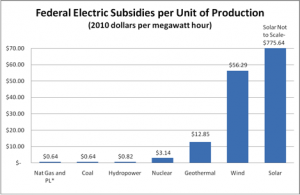from NCPA,
12/4/13:
 How should energy subsidies be measured? Dr. Roy Cordato, vice president for research at the John Locke Foundation, offers a new approach to measuring government subsidies.
How should energy subsidies be measured? Dr. Roy Cordato, vice president for research at the John Locke Foundation, offers a new approach to measuring government subsidies.
It is easy to manipulate the numbers when it comes to talking about subsidies. For example:
- In 2009, the Environmental Law Institute wrote: "The federal government provided substantially larger subsidies to fossil fuels than to renewables. Subsidies to fossil fuels -- a mature, developed industry that has enjoyed government support for many years -- totaled approximately $72 billion over the study period, representing a direct cost to taxpayers."
- In 2011, the Institute for Energy Research reported: "Solar is being subsidized by over 1,200 times more than coal and oil and natural gas electricity production, and wind is being subsidized over 80 times more than the more conventional fossil fuels on a unit of production basis."
Those numbers are typical of today's energy debate. Green energy advocates will use total dollar amounts when they compare subsidies, without looking at the amount of energy generated by those subsidy dollars. The Environmental Law Institute's statement above fails to take into account that wind and solar energy are much smaller industries than natural gas, coal or oil.
On the other hand, free-market advocates tend to compare the amount of the subsidy with the amount of energy being generated. When one looks at subsidies per unit of energy production, the amount of wind and solar subsidies are dramatically larger than those going to traditional energy.
Cordato argues that the most accurate measurement is a "net subsidies" measurement. He would look at the amount of the subsidy as well as monetary value of policies that penalize the industry being subsidized in order to get a net value. For example:
- A net subsidies comparison would include tax breaks, direct money transfers, the monetized value of mandates to use specific energy sources, or any other special privilege granted to one form of energy over another.- The "penalty" side of the calculation would look at taxes, the cost of regulations on the energy source, and the monetary value of land use restrictions (e.g. ANWR drilling restrictions, or regulations that prevent wind power along mountain ridges).
Because government plays such a large role in energy markets, through subsidies and regulation, Cordata cautions that any comparative estimate regarding energy subsidies alone are incomplete and urges the use of a net subsidies formula.
More From NCPA:





